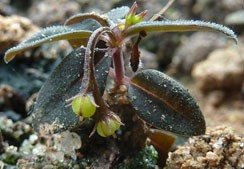Rutgers scientist part of international team to unearth unique tropical species
NEW BRUNSWICK, N.J.: – A new plant that buries its seeds, the first in its family, is discovered in the Atlantic forest of Bahia, Brazil, by an international team of scientists.The new species, appropriately named Spigelia genuflexa, displays a particular and rare characteristic that gives it its name. After fruits are formed, the fruiting branches “bend down,” depositing the capsules with seeds on the ground and sometimes burying them in the soft cover of moss, a phenomenon called geocarpy. This ensures that the seeds end up as close to the mother plant as possible, facilitating its propagation the following season. A famous example of geocarpy—a rare adaptation to growing in harsh or ephemeral environments, is the well-known peanut from the legume family that buries its fruits in the ground.

The discovery of Spigelia genuflexa was published on Sept. 14, in the scientific journal PhytoKeys, in an open-access paper available for free.
Amateur botanist Alex Popovkin knew right away that this was something brand new. He’s inventoried, photographed and identified over 800 plant species so far on his property in Bahia, Brazil, one of the areas of the world with the highest biodiversity.
“It’s taken me 30 years, from my days as a volunteer at the greenhouses of the Botanic Garden of the University of St. Petersburg, Russia, to realize my dream of living in the tropics and studying its plants up close,” said Popovkin.
“It is very easy to think we have found and described most plant species of the world already, but this discovery shows that there are so much left out there without name and recognition,” said botanist Lena Struwe of Rutgers School of Environmental and Biological Sciences.
Struwe, a professor in the Department of Plant Biology and Pathology, is no stranger to unusual species descriptions. She’s previously described a species in the gentian family from the Andes named after Harry Potter and another named after the Inca tribes.
Both taxonomy and biodiversity are in a current global crisis, but this discovery shows that “collaboration between amateurs and professional scientists, using both new molecular and traditional methods and making use of the facilities of the internet can lead to new discoveries and new efficient ways of documenting the world’s biodiversity,” added Struwe.
The journey to this important discovery had an interesting start. Two years ago, José Carlos Mendes Santos, a handy man called Louro who worked for Popovkin in rural northeastern Bahia, Brazil, hunched down behind a shrub for a common human activity. He spied an unusual tiny, inch-high plant with white-and-pink flowers, and as his custom from long working alongside a botanist, Louro brought it to the attention of Popovkin.
The tiny plant took up residence on the window sill of Popovkin’s house for closer observation. Its identification was an arduous task of contacting several taxonomic experts in Brazil, the United States and the United Kingdom, which led to establishing the family and the genus of the plant, but not the species.
Struwe, a specialist of the plant’s family, offered to collaborate with Popovkin on studying and publishing the new species. “It was clear that the plant was a member of the strychnine family, Loganiaceae, and its genus Spigelia, but not of a species previously known.”
Further collaboration with another expert in the strychnine family, Katherine Mathews from Western Carolina University, and visiting scientist Mari Carmen Molina from Spain, who extracted DNA from the plant in Struwe’s laboratory, led to the confirmation of the species as Spigelia, to which pinkroot, an old North American herbal remedy against intestinal parasites also belongs.
“The art of taxonomy is finding as well as being able to recognize something as new or different, which is hard when the world is home to millions of species and very few species experts,” offered Struwe.
Media Contact: Paula Walcott-Quintin
848-932-4204
E-mail: quintin@aesop.rutgers.edu